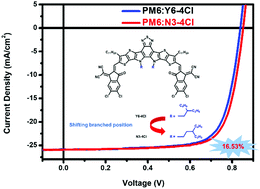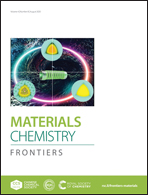Improved organic solar cell efficiency based on the regulation of an alkyl chain on chlorinated non-fullerene acceptors†
Abstract
Non-fullerene acceptors (NFAs) have attracted significant research attention as they enable high-performance organic solar cells (OSCs). Recently, a new NFA named Y6 was reported to yield highly efficient OSCs with efficiency up to 15.7%. Then, the research interests regarding the structure–property relationship and further structural optimization of Y6 have risen sharply. In this study, we report a new NFA, N3-4Cl, using IC-2Cl as the end group and replacing the alkyl side chains on the N-position of the pyrrole unit with branched side chains on the third position. The combined substitution on Y6 yields electronic effects on energy levels and thus the open-circuit voltage (Voc) of the corresponding OSCs. The lowest unoccupied molecular orbital (LUMO) level of N3-4Cl is up-shifted compared to that of Y6-4Cl; thus, a higher Voc of 0.85 V is obtained. In addition, PM6: an N3-4Cl blend film can also maintain an optimal blend morphology with reasonably high and balanced charge mobility, which leads to a high fill factor (FF) of up to 74.9%. As a result, PM6:N3-4Cl-based device reached a PCE of 16.5% in binary devices. The results suggest that tuning the side chains of NFAs is an effective method for optimizing energy levels and aggregation properties, thus enhancing the OSC performances.



 Please wait while we load your content...
Please wait while we load your content...